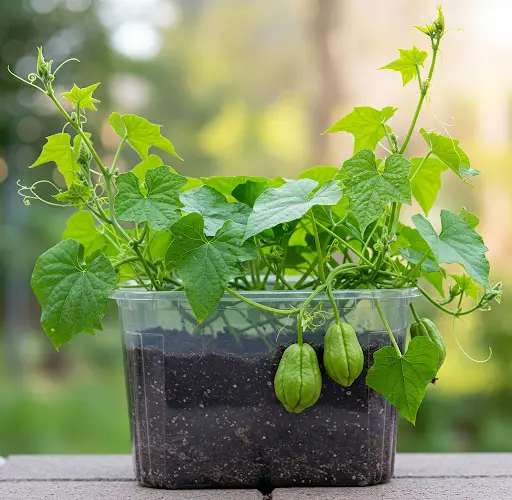Chayote, also known as vegetable pear or mirliton, is a versatile and nutrient-rich gourd that thrives in warm climates. It’s popular in many cuisines for its mild flavor and tender texture. While most fruiting vegetables demand a steady diet of fertilizer, there’s a natural, low-maintenance method that allows chayote to flourish without any added chemicals or compost. The result? A surprisingly bountiful harvest—with minimal effort.
This article explores a unique, fertilizer-free way to grow chayote that still produces heavy yields. It’s ideal for home gardeners seeking a more organic, hassle-free approach or for anyone working with limited resources.
1. Why Chayote Grows Well Without Fertilizer
Chayote is a vigorous vine in the gourd family that grows quickly and adapts well to different soil types. What makes it especially interesting is its ability to pull nutrients from deeper layers of soil through an extensive root system. When planted correctly, it doesn’t rely heavily on added fertilizers to thrive.
Its leaves act as natural mulch, and the plant’s spreading nature shades the soil, helping retain moisture and suppress weeds—two factors that also reduce stress on the plant and promote strong fruit development.
2. Choose a Mature Fruit for Planting
Unlike most vegetables grown from seeds, chayote is typically propagated from the whole fruit. Select a mature, slightly wrinkled chayote that has started sprouting from the top. These sprouts signal that the fruit is ready to grow.
Steps:
-
Choose a healthy, unblemished chayote that has begun to sprout.
-
Avoid green, overly hard fruits, as they may not germinate easily.
The sprouting chayote contains all the nutrients and energy needed to fuel early plant growth without external feeding.
3. Plant Directly into the Soil or Large Containers
This method involves planting the entire sprouted fruit directly into the ground or a deep container. No fertilizer is needed at the time of planting.
Planting tips:
-
Dig a hole about 4–6 inches deep.
-
Place the sprouted end facing upward and bury two-thirds of the fruit.
-
Water well after planting.
Choose a location with well-draining soil and at least 6–8 hours of sunlight daily. Chayote prefers warmth and space to spread, so plan for vertical or horizontal growth support.
4. Use Natural Trellising for Maximum Yield
Chayote vines can grow aggressively and benefit greatly from a trellis or arbor. This encourages better airflow and sun exposure, which leads to more flowers and fruit.
Trellis ideas:
-
A bamboo or wooden frame
-
A garden fence or wall
-
Hanging ropes or netting
Growing vertically also makes it easier to monitor growth, control pests, and harvest fruit.
5. Moisture Matters More Than Fertilizer
While most vegetables depend on added nutrients, chayote focuses on consistent moisture to produce abundant fruit. The sprouted fruit itself provides early nutrients, and the roots dig deep to access natural soil minerals.
Watering guide:
-
Water regularly to keep soil evenly moist—not soggy.
-
Mulch around the base of the plant with dried leaves or straw to retain moisture naturally.
As long as the plant is not stressed by drought or standing water, it will continue to develop healthy vines and produce fruit even without feeding.
6. Let Nature Take Care of Feeding
What truly sets this method apart is that no additional fertilization is required throughout the growing season. Once established, chayote can create its own micro-ecosystem.
Falling leaves from the plant itself create a natural compost layer, returning nutrients to the soil. Earthworms and soil microbes also contribute by breaking down organic matter around the base.
Optional enhancement:
-
Occasionally top up with grass clippings or dried leaves to simulate forest-floor conditions.
-
Avoid synthetic fertilizers, which can disrupt the plant’s natural balance and lead to excessive foliage instead of fruit.
7. Harvesting and Replanting
Chayote fruits are typically ready for harvest 4 to 6 months after planting, depending on climate and care. You’ll know they’re ready when they’re firm and bright green, but not overly hard.
Harvesting tips:
-
Cut the fruit carefully from the vine to avoid damage.
-
Pick regularly to encourage continued flowering.
After the growing season, allow one or two fruits to mature fully and sprout again. These can be replanted for the next season, continuing the cycle without the need for purchased seeds or fertilizers.
Final Thoughts
This natural, fertilizer-free method of growing chayote may come as a surprise, but it proves that you don’t always need to rely on chemical or even organic fertilizers to get a productive garden. With the right conditions—sunlight, moisture, and room to grow—chayote can thrive almost entirely on its own.
Whether you’re an eco-conscious gardener or simply someone looking for a low-maintenance crop, this technique offers a reliable and rewarding way to grow chayote at home. Try it out, and you may find yourself harvesting more fruits than expected—all from a single sprouting vegetable.



